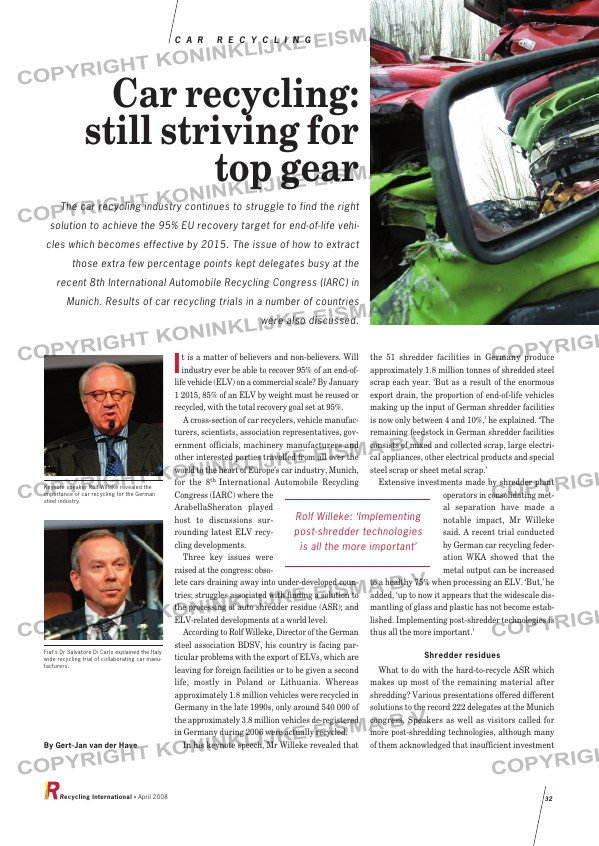Page 32 from: April 2008

I t is a matter of believers and non-believers. Willindustry ever be able to recover 95% of an end-of-
life vehicle (ELV) on a commercial scale? By January
1 2015, 85% of an ELV by weight must be reused or
recycled, with the total recovery goal set at 95%.
A cross-section of car recyclers, vehicle manufac-
turers, scientists, association representatives, gov-
ernment officials, machinery manufacturers and
other interested parties travelled from all over the
world to the heart of Europe’s car industry, Munich,
for the 8th International Automobile Recycling
Congress (IARC) where the
ArabellaSheraton played
host to discussions sur-
rounding latest ELV recy-
cling developments.
Three key issues were
raised at the congress: obso-
lete cars draining away into under-developed coun-
tries; struggles associated with finding a solution to
the processing of auto shredder residue (ASR); and
ELV-related developments at a world level.
According to Rolf Willeke, Director of the German
steel association BDSV, his country is facing par-
ticular problems with the export of ELVs, which are
leaving for foreign facilities or to be given a second
life, mostly in Poland or Lithuania. Whereas
approximately 1.8 million vehicles were recycled in
Germany in the late 1990s, only around 540 000 of
the approximately 3.8 million vehicles de-registered
in Germany during 2006 were actually recycled.
In his keynote speech, Mr Willeke revealed that
the 51 shredder facilities in Germany produce
approximately 1.8 million tonnes of shredded steel
scrap each year. ‘But as a result of the enormous
export drain, the proportion of end-of-life vehicles
making up the input of German shredder facilities
is now only between 4 and 10%,’ he explained. ‘The
remaining feedstock in German shredder facilities
consists of mixed and collected scrap, large electri-
cal appliances, other electrical products and special
steel scrap or sheet metal scrap.’
Extensive investments made by shredder plant
operators in consolidating met-
al separation have made a
notable impact, Mr Willeke
said. A recent trial conducted
by German car recycling feder-
ation WKA showed that the
metal output can be increased
to a healthy 75% when processing an ELV. ‘But,’ he
added, ‘up to now it appears that the widescale dis-
mantling of glass and plastic has not become estab-
lished. Implementing post-shredder technologies is
thus all the more important.’
Shredder residues
What to do with the hard-to-recycle ASR which
makes up most of the remaining material after
shredding? Various presentations offered different
solutions to the record 222 delegates at the Munich
congress. Speakers as well as visitors called for
more post-shredding technologies, although many
of them acknowledged that insufficient investment
C A R R E C Y C L I N G
Recycling International • April 2008 32
Car recycling:
still striving for
top gear
The car recycling industry continues to struggle to find the right
solution to achieve the 95% EU recovery target for end-of-life vehi-
cles which becomes effective by 2015. The issue of how to extract
those extra few percentage points kept delegates busy at the
recent 8th International Automobile Recycling Congress (IARC) in
Munich. Results of car recycling trials in a number of countries
were also discussed.
By Gert-Jan van der Have
Keynote speaker Rolf Willeke revealed the
importance of car recycling for the German
steel industry.
Fiat’s Dr Salvatore Di Carlo explained the Italy
wide recycling trial of collaborating car manu-
facturers.
Rolf Willeke: ‘Implementing
post-shredder technologies
is all the more important’
RI_028 (IARC) Car recycling:Opmaak 1 03-04-2008 15:18 Pagina 32



